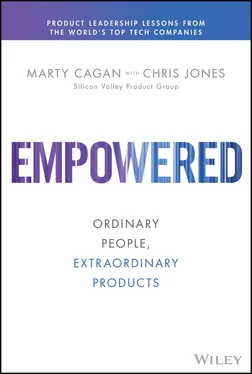1 ...8 9 10 12 13 14 ...18 An example of this might be that we have a person in a product team leadership role—similar to the general manager of a small business unit—and that person might come from any number of backgrounds. Let's say for the purposes of this discussion that she comes from business development.
Now let's say the members of the cross‐functional product team all report to her. But she has never been a product manager, or a designer, or an engineer. How can she coach her reports?
While it is our first choice to have the manager be the coach, when this is not possible, we can still provide effective coaching. The key is that someone in the organization needs to be tasked with providing the necessary coaching.
So, for example, there may be a design manager from another part of the organization that is asked to provide the necessary coaching to the designer. Similar for the product manager, and for the engineers.
The key is to ensure that, one way or another, coaching is considered a top priority, and that every person on a product team knows who is specifically assigned to help her develop and reach her full potential.
In this chapter, I will describe a coaching tool for helping managers of product people raise the level of performance of the people that report to them.
I want every product leader to feel considerable urgency and importance around this need.
Empowered product teams depend on competent product people, and if you don't develop your people and provide growth opportunities, there are usually other companies that will. I have always been a big believer in the old adage that “people join a company but leave their manager.”
This chapter explores the technique that I use and advocate for assessing a product manager . It is easily adjusted for product designers or tech leads.
It is the foundation for then coaching the person to success (the coaching plan , which we'll discuss next).
This assessment is structured in the form of a gap analysis. The purpose is to assess the product person's current level of competence along each of several necessary dimensions, and then compare that with the level of competence that's expected for this particular role.
This format acknowledges that not all skills are equally important, not all gaps are equally significant, and expectations change with the level of responsibility. This tool is intended to help focus the attention where it is most needed.
People, Process, and Product
As readers of INSPIRED know, the taxonomy I like to use when talking about product is the three pillars: people, process, and product.
For purposes of the assessment tool, I like to cover product first because product knowledge is the foundation for everything else. Without competence in product knowledge, the rest doesn't really matter.
User and customer knowledge—Is the product manager an acknowledged expert on her target users/customers?
Data knowledge—Is the product manager skilled with the various data tools and considered by her product team and her stakeholders as an acknowledged expert in how the product is actually used by users?
Industry and domain knowledge—Is the product manager knowledgeable about the industry and domain? Does she understand the competitive landscape and the relevant industry trends?
Business and company knowledge—Does the product manager understand the various dimensions of your company's business, including marketing, sales, finance (both revenue and costs), services, legal, compliance, privacy, and so on? And do the stakeholders believe that the product manager understands their concerns and constraints?
Product operational knowledge—Is the product manager considered an acknowledged expert on how her product actually works? Would she be able to effectively demo to a prospective customer, train a new customer on how to successfully use it, and handle live customer support inquiries?
Product knowledge really is table stakes. A new product manager typically requires two to three months to ramp up to speed on product knowledge, assuming she dives in aggressively and spends several hours per day learning.
Process Skills and Techniques
Product discovery techniques—Does the product manager have a strong understanding of the product risks and how to address each of them? Does she understand how to tackle risks up front, before engineers are asked to build? Does she know how to solve problems collaboratively? Does she focus on outcome? Does she understand and utilize both qualitative and quantitative techniques?
Product optimization techniques—Once a product or new capability is live and in production, does the product manager know how to utilize optimization techniques to rapidly improve and refine her product?
Product delivery techniques—While the product manager's primary responsibility is discovery, she still has an important supporting role to play in delivery. Does she understand her responsibilities to the engineers and to product marketing?
Product development process—Does the product manager have a solid understanding of the broader product‐development process including discovery and delivery, as well as the product manager's administrative responsibilities as the team's product owner?
New product managers are expected to know the basic techniques, but strong product managers are always developing their skills and learning new and more‐advanced techniques. Much like a good surgeon is constantly following the latest learnings on surgical skills and techniques, a strong product manager always has more to learn in terms of skills and techniques.
People Skills and Responsibilities
Team collaboration skills—How effectively does the product manager work with her engineers and product designer? Is it a collaborative relationship? Is there mutual respect? Is the product manager involving the engineers and designer early enough and providing them direct access to customers? Is the product manager fully leveraging her team's skills and minds?
Stakeholder collaboration skills—How good is the product manager at collaborating with her stakeholders across the company? Do they feel like they have a true partner in product that is genuinely committed to their business success? Has she established mutual respect and mutual trust with each stakeholder, including the senior leadership of the company?
Evangelism skills—Is the product manager able to effectively share the product's vision and product strategy, and motivate and inspire her product team as well as the various stakeholders and others in the company who must contribute to the product in one way or another?
Leadership skills—While the product manager does not actually manage anyone, she does need to influence and inspire people, so leadership skills are important. Is she an effective communicator and motivator? Do her team and stakeholders look to her for leadership, especially in stressful situations?
People skills are similar to product knowledge in that if you don't have a solid foundation, it is very hard to do the PM job at all. Yet, as with process skills, strong product managers constantly work to improve and develop their people skills.
Note that the taxonomy above is the set of skills and techniques that I generally use. However, in certain situations, I customize this list based on the company's culture or the company's industry.
As an example, in media companies there is a special and critically important relationship between product and editorial, and I like to call out this relationship explicitly and not leave it bundled in with other stakeholders. Which is to say, if you as the product leader think you should adjust this taxonomy of skills, then by all means you should do that.
Читать дальше











